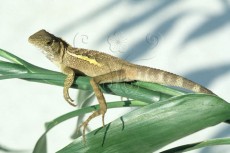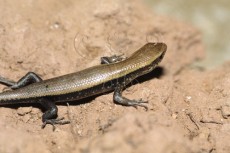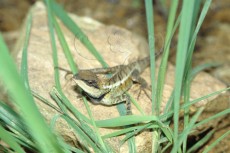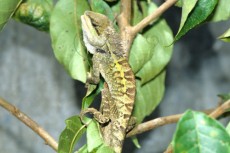TELDAP Collections
| The Evolution of Lizards |
|
1.Evolution at different levels To understand these dramatic diversification events of lizard evolution, we will need to examine the history of lizards on two levels: (1) the macro level, which reflected the origins of the higher-tier branching of lizard evolution, and (2) the micro level(s), or specifically, the points of differences, which reflected evolutionary events that occurred more recently. Therefore, we will first examine the evolution of the higher tier groups, then return to look at portions that seem like exceptions to the established theories.
Let’s look at the Sphenodons (tuataras) again. They are the only surviving genus of the Sphenodontia, and also the sister group of the Squamata. Except for a few body features, tuataras are thought to morphologically resemble lizards. Tuataras live in low temperature environments and operate their body at low temperature; they have extended many aspects of their living styles due to a short life-span. The morphology of the tuataras is still an unsolved mystery.
Sphenodons (tuataras and other similar fossils) possess large jaw adductor muscles and powerful bites; however they can’t open their jaws wide enough and close rather slowly. The skull of the tuatara has two temporal arches (double-nested) and a fixed quadrate bone. The skull of an iguana is similar to the tuatara, except that it does not have the lower temporal arch, and behind the lower temporal fenestrae is a rotating quadrate bone that is connected to the upper temporal arch. This new type of lower jaw suspension structure (the so called joint type) not only allows greater opening of the mouth, but also increases the opening and closing speeds. As new muscle tissues evolved, greater mechanical advantage is obtained as the bite power increases. The advent of joint structure is perhaps the key factor that allows the snakes and lizards to develop new predation strategies and more diverse feeding habits. Although the skulls of the Scleroglossa lizards are not as tough as the iguanas, they are more flexible and underwent major changes in order to dig through earth. The upper temporal fenestrae either turned smaller or disappeared altogether, making the temporal bones narrower. The majority of the Scleroglossa lizards have two additional flexible points on their skulls, which give them the ability to utilize mesokinesis for predation. Lizards with this type of mechanical ability have flexible upper jaws that can conform to the shapes of prey. This ability may be attributed to the increase of successful predation rate, and also allow hunting of more agile prey. When combined with changes occurring on the Scleroglossa lizards, this joint structure not only opens up new possibilities for predation strategies, but also allows lizards to respond appropriately to key habitat transfers (e.g. earth tunneling) occurring during evolution.
2.Evolution of Iguanas
The Iguanidae (includes 3 families and about 1230 species) lizards retain some features of their ancestors, one of which is a fleshy tongue that is used to catch small prey. Iguanas can shoot their tongues out of their mouths, which will latch onto the prey and retract them back into the mouth. This process is called the tongue feeding method. The tongue of most iguanas is short and obtuse tipped, but in some species the length of the tongue can double that of the body length. The chameleons have mastered this technique and developed a complex tongue ejection mechanism for feeding.
Although the olfactory sensing ability of the iguana is still in development (except for the herbivorous species, which will be discussed later), the tuataras have evolved both nasal and vomeronasal olfactory organs. However, the ability to visual detect prey is more important to these stationary feeders. Some species like the chameleons have perfected their art of predation by evolving visual magnification of distant prey; others, like the anoles lizards, have evolved mechanisms to detect mobile prey, and can sense even the slightest movement. As a result, these iguanas become more and more stationary than their ancestors, due to the development of these feeding methods.
Because stationary feeders often have to remain fixed at a spot for long periods of time, to survive natural selection they have evolved a beneficial system of evasion, based on conformity to background colors and camouflage patterns to interfere with detection from potential natural enemies. The iguanas are the most covert members of all species; their abilities are matched only by some geckos (also stationary feeders). An ambushing predator could see a moving prey but not an immobile one. Iguanas can remain motionless waiting for prey, while regulating body temperature by sun bathing at the same time. The Anguimorphs have to move to look for prey; therefore they cannot feed while sunbathing. However, due to ample sunlight and high ambient temperature, the desert-dwelling Anguimorphs do not require as much sun bathing time as other species; those that live in tropical regions, however, will require more time to obtain enough heat for the body to use.
Lastly, iguanas have a social structure based on territories. A “territory” is a clearly defined region of personal defense. Although it seemed like a reasonable evolution route for stationary lizards with camouflage patterns, territorial behavior is not just limited to the stationary feeders.
Stationary feeding, camouflage and territorial – this series of lizard characteristics are related closely to each other; however the details of connection between them have not yet been elucidated. For example, the carnivorous iguana, with its multitude of features, is truly the expert of its niche environment. Imagine how odd it would be for a dead-leaf looking lizard to perch among green leaves.
Iguanas, with their camouflage patterns, greatly reduced the possibility of becoming targets for their enemies, especially predators that rely on visual detection to catch their prey. Therefore, the choice of reproduction for these iguanas must also diversify toward beneficial directions like the morphological features. Stationary lizards can survive longer due to their camouflage patterns, and thus are able to take care of large nests of eggs without spending much reproductive expenditures related to mobility. Some horned lizards are able to lay eggs that weigh as much as the maternal weight. In contrast to the iguanas, the stream-lined shaped anoles lizards live on the stems of flowers and grass, and they only lay one egg in each nest. As a result, not only is the weight reduced, the inconvenience associated with a narrow habitat is also resolved. To counter the drawback of laying only one egg at a time, anoles lizards will lay eggs continuously during mating seasons.
Let’s summarize from a higher classification viewpoint: iguanas are stationary feeders that rely on visual acuity to detect prey; they are skilled in camouflaging themselves and survive on low to medium body metabolism and a wider range of active body temperature. They live in defensive territories arranged in mosaic like patterns, and each individual has its own area to defend. In many cases, iguanas outline their territories along the axis of their habitats, making it difficult to discern whether other types of lizards also inhabit the same area. Iguanas often stay at a safe area away from the prey, that way when camouflage fails they can quickly sprint to the nearest shelter. The ability to escape successfully depends on whether or not an iguana can seek refuge in a shelter; and this short burst of motor activity used for evasion can be recovered with relatively small energy expenditure. There are, however, some iguanas that can sprint for a fair amount of distance on an open habitat, running in a zigzag like pattern.
The decorative display of sexual dimorphism reaches its zenith in iguanas. An example of excessive display is the horns on the male Jackson’s chameleon. Because they rarely change their positions, these decorative growths do not interfere with their movement. In fact, it may even be necessary for these features to disrupt the body pattern of the lizard to reinforce its camouflage; otherwise it may be detected by predators. Similar decorative features however would not work on tunnel boring species such as the Amphibaenia, which would interfere with its lifestyle adversely.
3.Evolution of Scleroglossa
It is not yet known what kind of selective pressure has resulted in the branching of the ancestors of Scleroglossa from the main lineage of lizards, leading to a brand new direction in evolution. The effect of this sub order on the classification of lizards is deep and profound. The Scleroglossa ancestors practice the technique of “lower jaw predation,” catch their prey using their lower jaws, rather than their tongues. This change might seem minute, but the result is astonishing. The movement to lower jaw predation has enabled Scleroglossas to develop a new type of hardened tongue, which receives stimuli from chemical signals and is used to detect the presence of the prey. This change from visual acquisition to chemical based discretion allows exclusion of poisonous or harmful targets, ensuring the quality of the prey. The display of sexual dimorphism has all but disappeared in these lizards, with only a few species retaining subtle differences in features like body size, head shape and color patterns.
Many features like the tongue morphology, sensory reception systems, feeding mechanisms, and foraging patterns start to change as the skulls of ancient lizards began to branch out into different specialization. When the Scleroglossa order branched out from the Iguanidae, two other suborders are also formed – the Gekkonidae and the Anguidae. The tongue of a Gekkonidae lizard is a compromised product derived from the catcher type tongues of the iguanas and the chemical sensing tongues of higher order lizards. This type of lizard tongue no longer sticks and carries prey to the mouth; rather it assists in transporting prey to the mouth.
4.Evolution of Geckos
The lizards of the Gekkonidae order are large stationary foragers, with a few exceptions. Like iguanas, geckos are largely immobile and live in a territorial based society. They rarely use their tongues and vomeronasal olfactory system to identify prey. The tips of their tongues are short, stubby and round - similar to the iguanas, but they do not latch onto prey. Geckos can move their tongues freely, and they use them to clean the membranes which cover their eyes – a feat that resembles a windshield wiper on a car and is unique to geckos. Similar behavior is also observed from the Xantusiidae, or the night lizards, which suggests that this species may be more related to the gekkos than the Scincomorpha. Color based sexual dimorphism is present on some diurnal geckos; however, body sized based dimorphism is rarely seen now except in some species (like the knob-tailed geckos – females are larger than males).
Geckos have some interesting twists in their evolution history. One of its branches, the snake-like Pygopodidae, has a genus that has lost the traditional feeding mechanisms employed by lizards. Behaving like a snake, the Pygopodidae will consume an entire lizard, using mesokinesis to subdue and swallow the prey. Some geckos have evolved adhesive toe pads (setae) or tail setae which allow them to move on smooth vertical surfaces. Others have developed enlarged vocal cords and can emit calling sounds like a frog, enabling social communication.
5.Evolution of Anguimorpha
The Anguimorpha follows a different route of evolution: adding vomeronasal organs to better assist its tongue (although the skinks still use their tongues to manipulate prey to some extent). This feature has significantly affected social behavior and prey recognition; having a sensitive detection mechanism like the vomeronasal organ enables the Anguidae lizards to perceive their surroundings as a world full of chemical suspension materials. This type of chemical sensory mechanism is closely related to a newer, more active style of feeding mode, which will go on to create a cascading effect influencing the morphology, physiology, behavior and ecology of these lizards.
The extension of the tongue enables these lizards to “taste” the environment. The tongue of the Anguidae became longer and more complex. The anterior part of the tongue is mainly used to receive chemical signals; the posterior end is used for actual feeding. Compared with a skink, the anterior and posterior part of a skink’s tongue can be discerned – the fore tongue is a slender hydrostatic extension. Larger lizards, like the whip-tailed lizards, and the small spectacled lizards have snake-like tongues. The whip-tailed lizards have deep grooves on their tongues, resulting in a fork like shape. However, the tongues of whip-tailed lizards are structurally different from the fork tongues of the snakes and Megalania lizards. The tongues from the latter two reptiles have lost their original function of feeding; instead, they are now primarily used to detect residual scents in the surrounding environments.
These brand new adaptations opened up new niches and prey resources for the Anguidae lizards, allowing a wide range of adaptive expansion to occur (there are close to 3000 species of Anguidae lizards and snakes). Chemical sensing also enables Anguidae to avoid harmful and poisonous prey. Similar to a chameleon, snakes and Megalania lizards caught their prey using their lower jaws, and proceed to chemically identify the prey. Some monitor lizards have developed the ability to swallow large prey, just like snakes.
Other forms of adaptive expansion proceed alongside the evolution of feeding mechanism and vomeronasal sensory system. Often, these lizards will change into a more active lifestyle, seeking prey on the run. The gain of increased mobility must have been significant, otherwise this form of lifestyle not only consumes energy, it also attracts the attention of predators. Although it’s difficult for visual based predators to detect stationary feeders like the iguanas, it is relatively easy for them to spot lizards that are constantly on the move. From an evolutionary standpoint, an active lifestyle is closely related to increased awareness and reduction of reaction time. Some lizards will even acquire mammal-like perceptive ability when their integrated neural development has reached a certain level. Most people who observe whip-tailed lizards or monitor lizards in the wild will be amazed at how these creatures can determine the movements of intruders, while foraging continuously at the same time. When the intruders have passed a certain threshold distance, these lizards will sprint to safety before returning to their normal activities. The high awareness and agile reaction of these lizards compensated for a fraction of energy cost spent on foraging. To support an active life style, a lizard must have high metabolic rate, higher active body temperature, elevated endurance, and most importantly reduced recovery period from motion.
6.Evolution of foraging patterns
Lizards that feed actively tend to have a greater range of activity, in which they move around constantly searching for food. In general, the defendable territory of an active foraging lizard is inversely proportional to its degree of activity. Most whip-tailed lizards, skins and Megalania lizards are active foragers; they do not actively defend their territories. Instead, the males will actively protect their mates while moving around in their territories. The reason why these lizards don’t actively defend their territories is because the females are outside the range males can effectively defend. In this case, the reproductive measure of these lizards went from the classical “resource defensive polygamy” of the iguanas to the system of “continuous mate protective polygamy.”
The main advantages of going from an ambush type predatory behavior to active hunting are increased range of available prey and potential mates. Foraging often coincides with social behaviors in these lizards. In contrast with iguanas, active foraging lizards are limited by their need to obtain heat from the sun, which supersedes all social behaviors including foraging. Otherwise, these activities will conflict with thermal regulation. Sexual dimorphism is common in these Anguidae lizards; rather than displaying decorative morphological differences, the gender traits of these lizards mostly differ by coloration, head and body size.
Lastly, there was an unknown legless ancestor species of the active foraging Megalania lizards. They have reduced eyes, long and bendable bodies and increased vertebrae. This is the origin of snakes.
National Museum of Natural Science
|


















